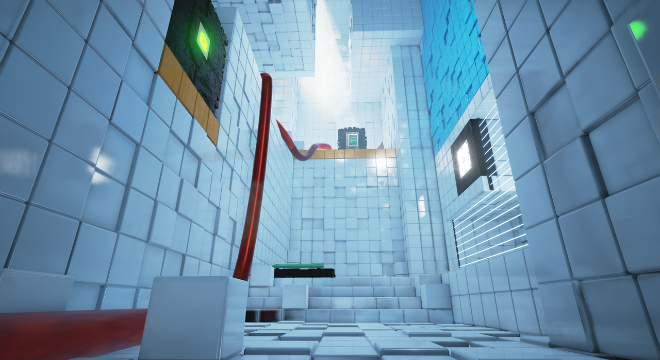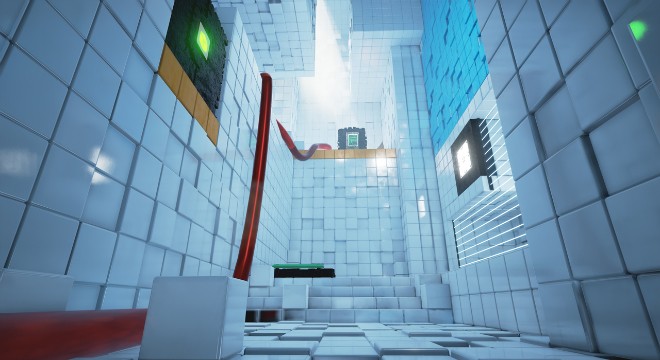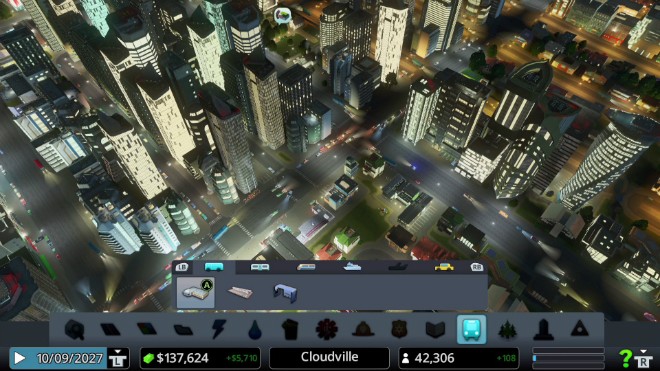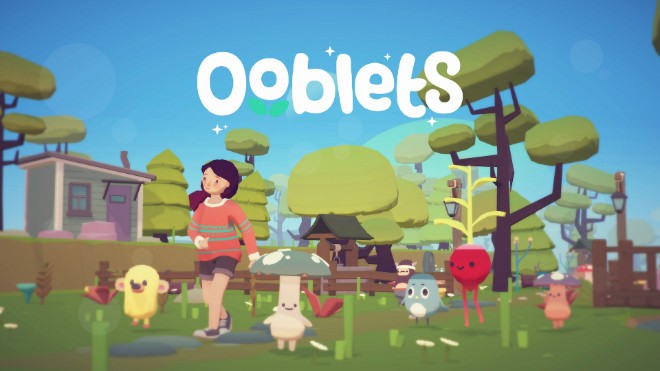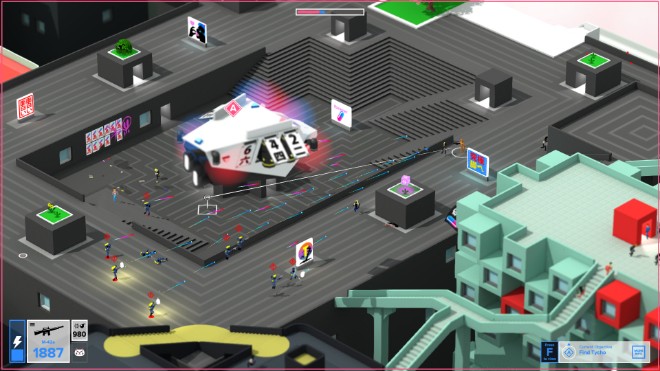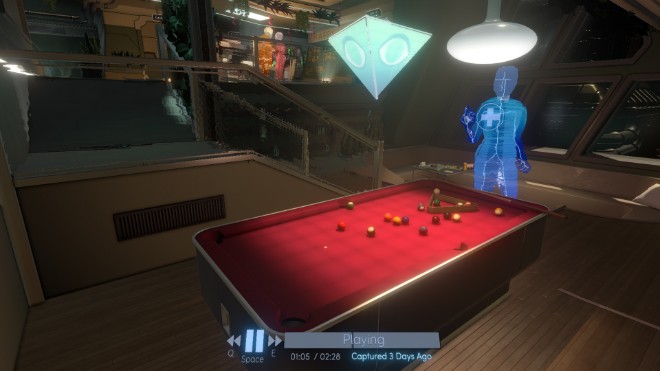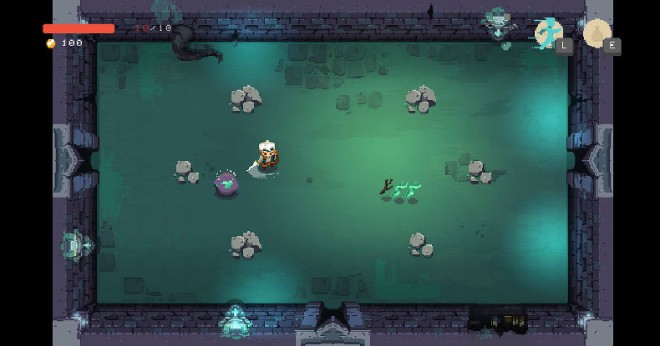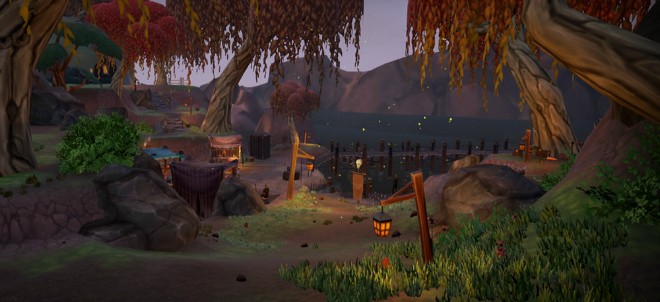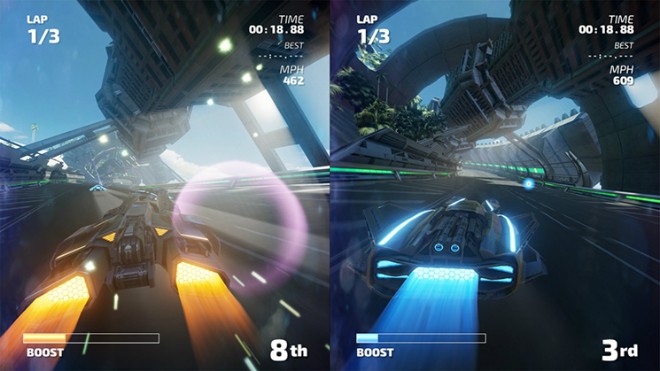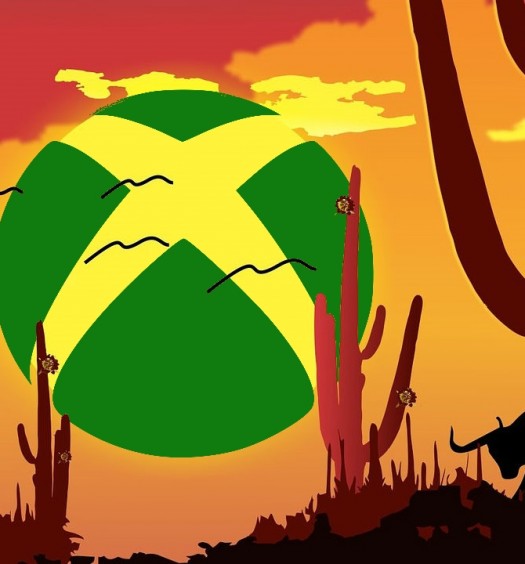This past weekend saw indie games from everywhere descending upon Tobacco Dock in London, U.K., for three days. This was EGX Rezzed, and I was there to go hands-on with some of the games and report back.
While EGX is the U.K.’s bigger show hosted every September, Rezzed is smaller and focuses on indie developers, though you’re no less likely to have to force your way through crowds assembled around TV screens, especially on the Saturday.
Xbox Games
Q.U.B.E. 2
I was a big fan of the first Q.U.B.E., of its puzzles and Portal-esque vibes… everything except that time trial mode. Q.U.B.E. 2 promises more of the same. Its white-panelled world is reminiscent of a psychiatric facility, which given the narrative arc of the first Q.U.B.E. was at times fitting.
Even though I was playing with a mouse and keyboard (the Xbox release is likely to be later than the PC release), the controls felt familiar and I was instantly solving puzzles. Immediately in the demo you were presented with three colors you could deploy onto the special tiles, a slightly different mechanic from the first Q.U.B.E., and they behaved slightly differently. Red would extend three units out; green would create a block that would detach from the panel (i.e. if the panel was on a wall, the block would fall); and blue would act as a springboard.
The short demo gave me high hopes that this would be more of the Q.U.B.E. I liked, yet different enough to make it compelling.
Cities: Skylines
Cities: Skylines, the popular city-building game on PC, is getting an Xbox One port. While I was at EGX Rezzed, it even had its release date confirmed: April 21, 2017. It’s just two weeks out.
I have wanted to play Cities for a long time, but with that eternal worry that the controls just would not map well onto a controller and that Colossal’s game would not be enjoyable once ported to console. Having spent some time with it, my fears have been mostly allayed.
For the most part, the controls have been crafted well around the Xbox One controller, and the UI remade to accommodate it: LB and RB tab you quickly between the different elements (from water and electricity to health buildings to your unique buildings) and from there it’s a combination of selecting and pressing A to put units into your world.
The only times I really felt I would prefer a mouse for input were when I was trying to quickly create several new roads for a new district, zoning areas (demarcating sections for commercial, residential or industrial use) and, especially, when building bus routes. Bus routes, in particular, were extremely fiddly; the game makes up for it by using some intelligence to predict a route and then you can place your bus stops, but even so it was clumsy and getting the desired result took several attempts.
Even so, bus routes are a small part of the game, and overall I was left impressed with how Cities is shaping up on console.
Ooblets
Ooblets is a cutesie game coming to Xbox One and PC with Double Fine backing it as publisher. It immediately invokes comparisons with Animal Crossing for its aesthetic and Pokémon for the little creatures that you aim to collect and use in battle.
In the demo I played, you arrive in the town by train, and your friend meets you before she runs off to do… something. In the meantime, you venture into town and without knowing anything really at all pick an Ooblet club to join. The three potential recruiters are all excited for you to join them, but equally happy when you choose someone else. Everyone is always happy.
Next, I located my farm (not easy – it appeared to be in the opposite direction of what I thought I had been told), at which point I did a little farming, planting seeds and watering them to grow Ooblets. With two Ooblets in tow, it was time to venture onto the path I had been warned off earlier and do battle with fellow trainers.
Battles are what you would expect: turn-based, pick an attack and kill off the opposing Ooblets. If you beat them, you get a seed that will help you grow that type of Ooblet. The first player I defeated even healed my Ooblets for me. (Seriously, everyone is happy all the time.)
Ooblets is not your standard console fare, at least for Xbox. It looks like it got lost on its way to Nintendo, and that’s not a bad thing. It feels like it will be relaxing and charming, and will be treasured for its upbeat nature.
Tokyo 42
In Tokyo 42 you find an isometric shooter/stealth game. It bills itself as “the lovechild of Syndicate and GTA 1, ” and I attempted two missions during my time with it.
The first mission was stealth: to assassinate a target using only melee attacks (in this case, a katana) and to escape without being spotted. It took a few tries to get used to the enemy movement, the controls and the camera, but success felt good. As the assassin you can jump from ludicrous heights and survive but sometimes landing is tricky and it’s quite easy to completely miss the staircase and instead plunge to your death.
While in terms of art style, the game reminded me of the Team 17-published LA Cops. In Tokyo 42, the missions appear to take part across an open world (or at least open levels, it being hard to judge the size of the game from the demo). My first mission was on one side of the world, and for the second I had to run back.
The second mission was brutal: the aim was to assassinate the target using a grenade, but the target itself was in a heavily-fortified position with only one entryway.
The long-term entertainment of Tokyo 42 will depend on the variation in the missions, “assassinate target X with weapon Y” can only be repeated so many times, but it shows strong potential and visually looks great.
Tacoma
The Tacoma demo was a bit odd. It was very short, which makes sense for any kind of show like Rezzed where you want relatively quick turnover at each station, but it ended right as I was beginning to get interested in the world.
Maybe that’s intentional, but it was only just as I started wanting to learn something that it ended, rather than leaving me with something meaningful, or a nugget of the story that I actually cared about, and I wonder if I didn’t somehow trigger the ending prematurely.
Still, the demo sets up a rich world, in which you appear to be the only (or one of few) survivor of a spaceship disaster. As you explore what remains, you can play back hologram recordings of your crewmates to uncover the stories of their stay aboard the ship. Playing back the recordings will also give you practical information, like the code to your commander’s office. (Seriously, spaceship-builders and SysAdmins, that seems like a security flaw.)
You can even shoot some hoops in a passageway by grabbing a basketball early on or later play some pool by resetting the balls manually. Both activities seem like they’re without purpose, and in so doing help you believe you’re on an actual spaceship where actual crew members had to work and live for months or years.
Moonlighter
Moonlighter… to get this out of the way early, let’s just say it looks a lot like Binding of Isaac. Moonlighter is a roguelike dungeon explorer, and while in the dungeons it bears more than a passing resemblance to Isaac, but then it has an interesting twist: the reason you’re exploring all these dungeons is to stock your shop. You come from a long line of shopkeepers, and during the day you can open the shop to sell your wares.
The demo itself was not great at explaining what you needed to do, and after the initial tutorial teaching me how to sell and how to recognise whether customers were happy with my prices, I could not trigger it to allow me to open the shop again. It also took a while before I found my way back to the dungeons, there being five you can enter.
That aside, Moonlighter promises some interesting things. Justifying the dungeon exploration as a way to keep your shop running is an interesting move, and the cash from that will help you purchase upgrades so you can deeper into the caves, for longer, and eventually explore the other four caves.
Nerve
While targeting an initial release on Steam and PS4, where it can hit all the VR headsets, Nerve is also looking at an Xbox launch.
In Nerve, the aim of the game is, simply, to not die. You are hurtling along the outside of an endless cylinder with obstacles coming at you unrelentingly. The controls are simple: the left stick steers, left trigger gives you a limited-time slow-down, and the right trigger gives you infinite boost. In the Rezzed demo, you have five minutes to get as far as possible through this obstacle course; within the five minutes, there are infinite respawns; after five minutes, your next death is your last, and it’s all over.
While the game will launch in both VR and “2D” versions, at Rezzed Nerve was being demoed in VR, my first experience of the Oculus Rift. I have previously played the 2D version, and it is a perfectly adequate way to play, but VR elevates it. I saw other players literally ducking and weaving on their stools to avoid, and see past, obstacles.
In the full game, rules will change, and it’ll ask players to focus on completing levels in the fastest time manageable, but for shows like Rezzed, the five-minute rule and tracking distance as a score worked perfectly. They even turned it into a leaderboard: improving your scores is oddly addictive and instantly competitive (everyone at the show is your nemesis).
Non-Xbox Worthy Mentions
Tetra (PC)
The result of four university students, Tetra, is not the typical game I would play. It was described to me as ‘single-player World of Warcraft’. The game is far from finished, but for four months’ work, it shows remarkable promise.
In the demo, the player takes control of four heroes (among them, a tank and a healer) and attempts to defend a fountain from waves of enemies. Occasionally the camera would jump inside a character when standing too close to the fountain, but it’s nothing that can’t be excused when considering this is only four month’s work on a first-time project.
Assuming control of all four characters means that the AI handles the other three at any one time, but you can freely switch between them. Each character has four unique powers, activated on the number keys 1-4, while tab quickly switches targeting between enemies.
After only four months in development, the students have created something that was at least worthy of being played at a game show, and have turned to Kickstarter to finance another year’s worth of development to turn Tetra from project into a fully-realised game.
Fast RMX (Switch)
Fast RMX gave me my first experience of the Nintendo Switch. It is a Wipeout-like racing game, with a slight twist to how it handles boost that makes it at least slightly unique and keeps your mind racing as your vehicle does. There are two colors of boost – blue and gold – and you need to match your vehicle’s backlight to the color on the road; if you do, you get boost; if you don’t, hitting the boost strip actually slows you down.
The same applies to jumps: fail to match the colors, and you’re falling off the map instead of jumping to the next section with everyone else. (Fortunately, you respawn.)
Aside from that, Fast RMX feels like so many Wipeout-like games that have been seen over the years, but it at least attempts to differentiate itself, and being similar to other games doesn’t make it any less fun. The three randoms and I enjoyed our few races together.

